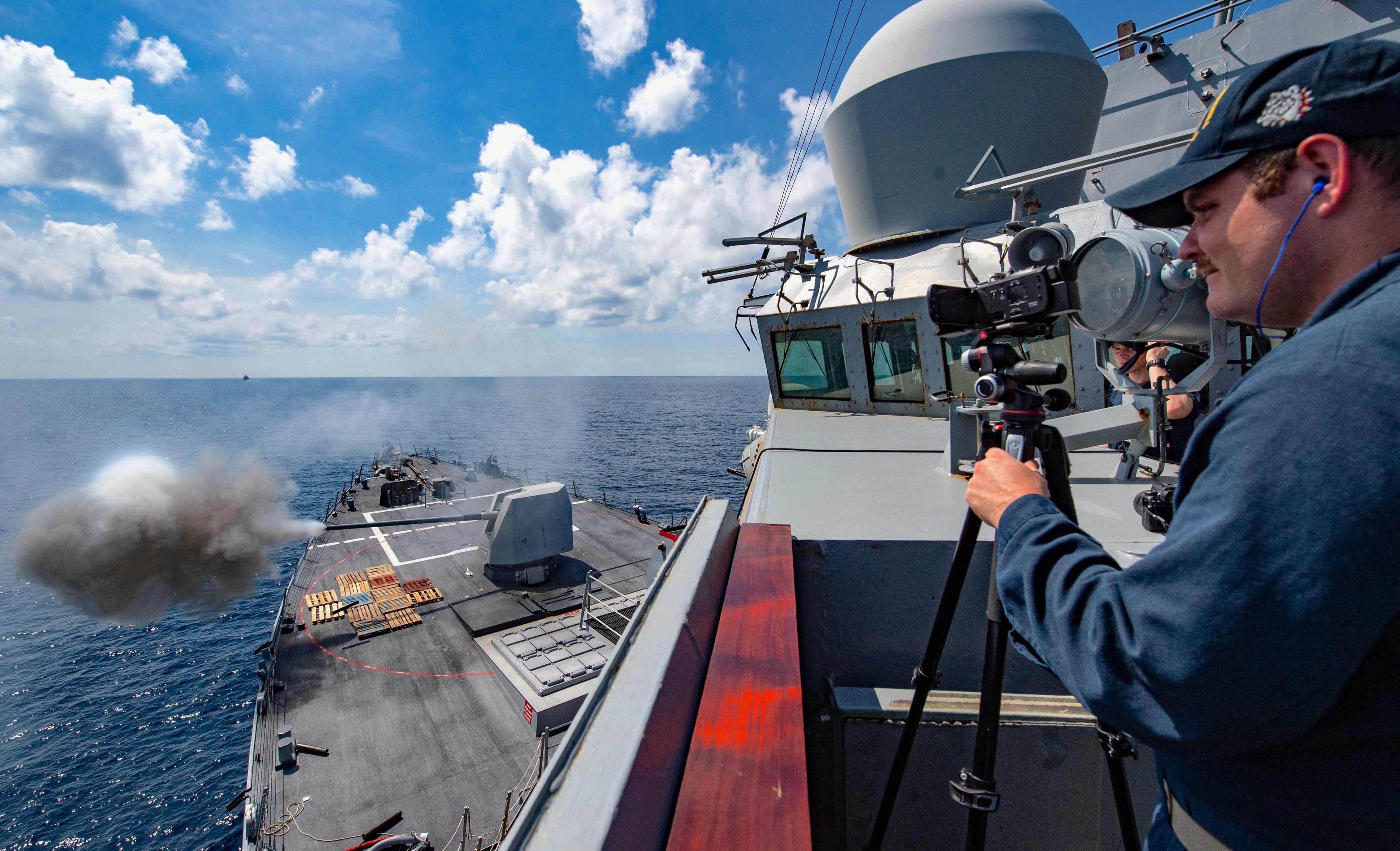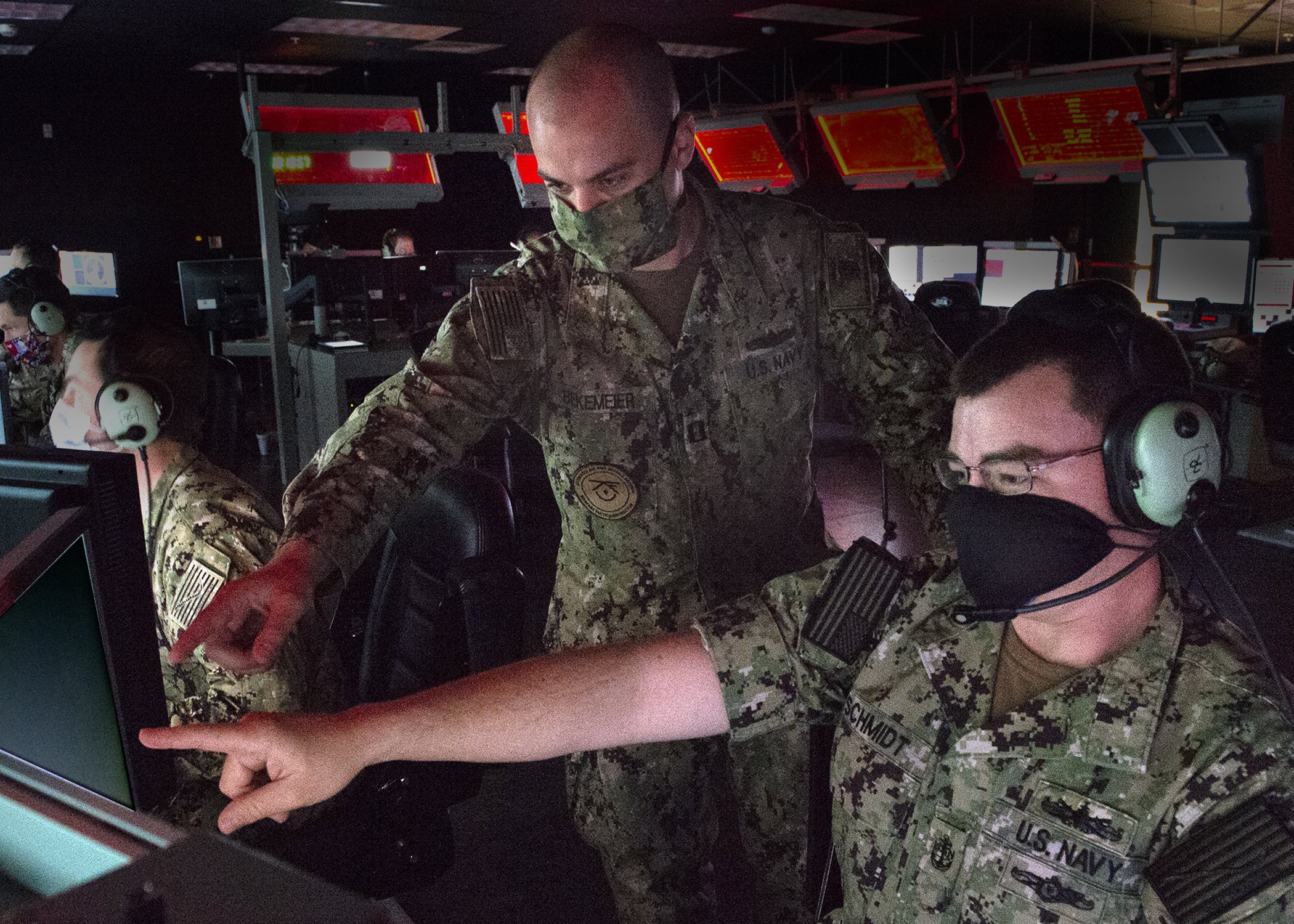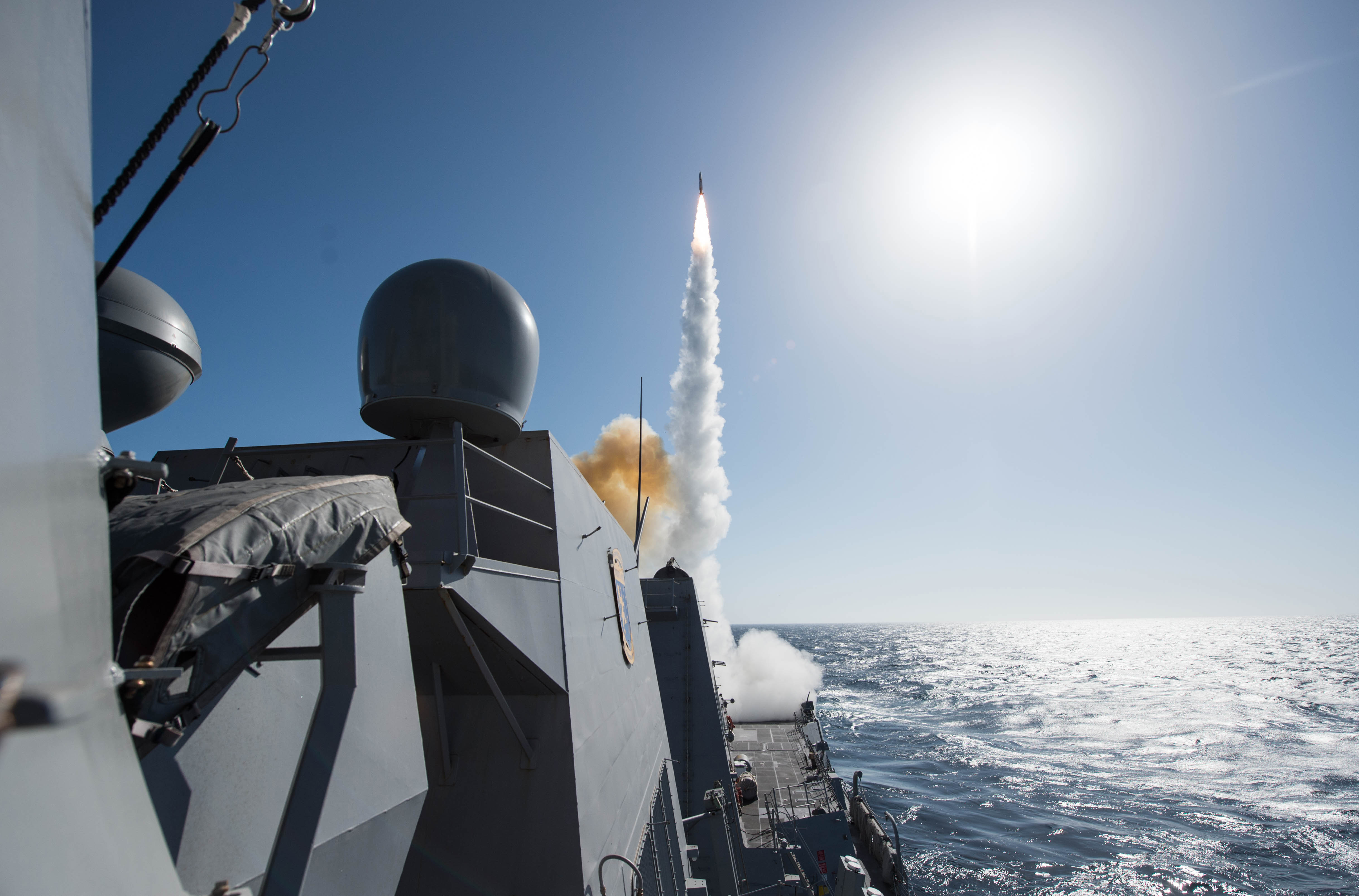
The Navy’s plans to create tougher advanced-phase training events for surface ships are made possible by improvements in individual-level training for surface warfare officers and sailors, according to the officers that oversee the spectrum of surface training.
Rear Adm. Scott Robertson, the commander of the Naval Surface and Mine Warfighting Development Center (SMWDC), described a next phase of advanced training events ahead of surface ship deployments, calling for a Surface Warfare Advanced Tactical Training (SWATT) 2.0 iteration that would have more combat-focused scenarios and would stress ship crews in a multi-domain fighting environment, he said during the Surface Navy Association’s Virtual Waterfront conference.
The Navy started holding SWATTs just a couple years ago, as an intermediary between single-ship basic training and carrier strike group-level integrated training during a Composite Training Unit Exercise (COMPTUEX). They center around Warfare Tactics Instructors (WTIs) embarking on surface ships and helping teach the crew how to approach anti-submarine, anti-surface, air and missile defense, amphibious or mine warfare tasks.
The WTIs walk the crew through a plan, brief, execute and debrief (PBED) process that the crew is supposed to take with them onto deployment to ensure more well reasoned reactions to the situations they find themselves in. Each SWATT includes at least one live fire event with missiles, as well as gunnery events and simulated attacks on enemy targets.
As a first example of SWATTS getting more complex in the near term, Robertson said, an upcoming SWATT event will call upon a ship to fire its 5-inch guns against a surface target while also shooting a Standard Missile-2 at an air target.

Within a couple years, though, SWATT 2.0 will take on a new look: while still retaining that focus on teaching the PBED process, Robertson said they will also:
- introduce nighttime events;
- incorporate live, virtual and constructive training opportunities that are already being featured during COMPTUEX events;
- remove or make more challenging today’s basic training portion of the SWATT curriculum;
- increase the complexity of gunnery events;
- add offensive and maneuver aspects to the “live fire with a purpose” missile shot events;
- add information warfare components;
- and add in a capstone event to the end, which would be an 18- to 24-hour “multi-domain, multi-warfare free play event designed to challenge warfare commanders, unit [commanding officers] and watchstanders alike in stressful conditions. With the inclusion of assess battle damage and opportunities for integration with shipboard training teams and toughness training, I believe it will be a game-changer for the advanced phase of training,” Robertson said during a pre-recorded video to accompany the SNA Waterfront panel presentation.
Reaching that SWATT 2.0 vision requires several changes, some within his portfolio and some outside.
Inside SMWDC, Robertson said changes are coming to develop more sophisticated WTIs. Right now, integrated air and missile defense (IAMD) WTIs are trained in Dahlgren, Va.; amphibious warfare WTIs are trained at Little Creek, Va.; mine warfare WTIs are trained in Point Loma, Calif.; and anti-sub/anti-surface WTIs are trained in San Diego.
Within the next two to three years, “we’ll bring them all together into one central WTI University here in San Diego. WTI University will still develop the four WTI specialties, but it will serve as a warfighting skills integrator that I view as absolutely critical for dominance in the high-end fight. It will be a state-of-the-art facility located here on the dry side of 32nd Street and will be a true center of excellence that will cultivate innovation and collaboration. This will be another exciting step in the professionalization of the surface warfare community,” he said in the video.

“Building more capable WTIs will be our gateway to delivering increased effectiveness and complexity of our SWATT. SWATT 2.0, as I like to refer to it, is our innovative approach to spiral up the complexity of SWATT to address new threats and to train to new capabilities. SWATT will always remain rooted in tactics, techniques and procedures, TTPs, and led by our extremely capable WTIs. But as WTI University generates even more highly trained surface warfare officers, SWATT will reflect their growing potential to deliver more challenging training,” he concluded.
During the panel discussion, Robertson said SMWDC had already procured a building on the naval base and was in the process of designing what the WTI University building would look like. The facility should be up and running in two or two and a half years, he added.
Asked by USNI News during the panel discussion what he would need from the rest of the Navy to pull off the SWATT 2.0 vision – which he said previously would require sailors to come into advanced training at a higher level of proficiency than they are today – the admiral said “we have to have a higher expectation coming into the advanced training phase from the basic phase. And so that means I’ve got more work to do here to help with our relationship with the Afloat Training Group to get beyond the basic level of understanding the warfare areas” during basic training. He said that may require WTIs to help coordinate some activities during basic phase training on a ship – where sailors and officers take their individual training and apply it to a team environment for the first time – so that basic phase training events are better tailored to support a smooth transition to SWATT 2.0.
He said he had worked closely with Carrier Strike Groups 4 and 15 – the integrated training commands on the East and West coasts that oversee COMPTUEX – to ensure that SWATT was training surface ships to the right level to succeed in ever-more-challenging COMPTUEXs. In that same vein, Robertson said he needed better alignment with ATG on basic training.
“To get to my SWATT 2.0 vision of really, not the crawl-walk-run but the walk-run-sprint methodology and the level of complexity of SWATT, we have to have a higher degree of readiness for coming into the advanced phase, and that’s going to take some work with us working with ATG,” he said.
Robertson praised organizations that conduct individual training – the newly renamed Surface Warfare Schools Command (SWSC), formerly Surface Warfare Officers School Command, which trains SWOs in overall mariner and maritime warfare skills, and the Center for Surface Combat Systems (CSCS) that then teaches them how to operate specific platforms and combat systems.
Robertson said their changes were moving the Navy in a good direction and that it would just take a bit more time to reap the benefits of those changes.
“Really what it’s going to take is us to get a little bit more run time with the great work that’s being done at the individual training level,” he said, noting that both commands were revising course curriculums, focusing on skills rather than facts, and adding in more lab and simulator time to build better watchstanders.
“This is all coming together: there’s tremendous momentum between the changes at SWOS, the changes being done at CSCS, that we are going to wind up with an aggregate level of individual skills and level of knowledge increase here coming up pretty quickly that is going to make our teams more ready,” Robertson said.
“There’s a chain effect: if I’m able to deliver better ships more prepared from the advanced phase, then that means the CSG 4 and 15 organizations, they can even up their game even further.”

During a separate presentation during SNA Waterfront, SWSC Commanding Officer Capt. Chris Alexander said that progress was being made in the surface community’s plans to advance the current junior officer of the deck (JOOD) course.
Alexander said the current iteration of the training, which more than 1,000 ensigns have already completed, is excellent.
“This is the training that I wish I had gotten 27 years ago when I first came in the Navy. I can say for the first time in my career, we are teaching our young officers how to properly stand watch on a bridge before they get to their ship,” he said.
Throughout the course, students learn an idea in the morning – maritime rules of the road, or how to plot courses – and then get to practice them in a simulator later that day. Students log about 85 hours in simulators by the end of the four-week course.
By this time next year, Alexander said, the course will be six weeks long, with an additional week on radar plotting and a week on electronic navigation charting. It will also be renamed OOD Phase 1.
OOD Phase 2 will be added by this time next year as well, a three-week course that will be offered to students between their first and second division officers tours. OOD Phase 2 will culminate in a go/no-go assessment meant to ensure that sailors who cannot complete the required tasks are not continuing on as surface warfare officers.
Just as this effort has been put into mariner skills for junior officers, a similar effort is underway to overhaul the maritime warfare training curriculum, he added. Revised curricula with a tactical focus will shape training for first tour division heads up through officers preparing to take command as executive officer or commanding officer.





